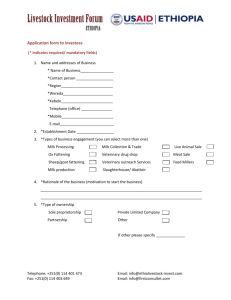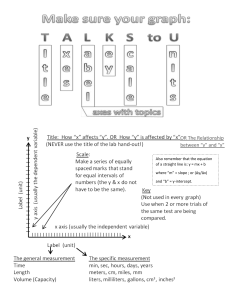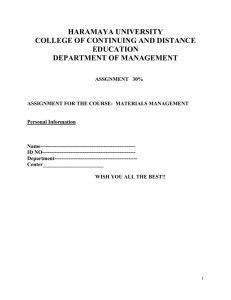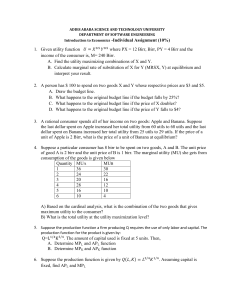Linear Equations: Definition, Forms & Applications
advertisement
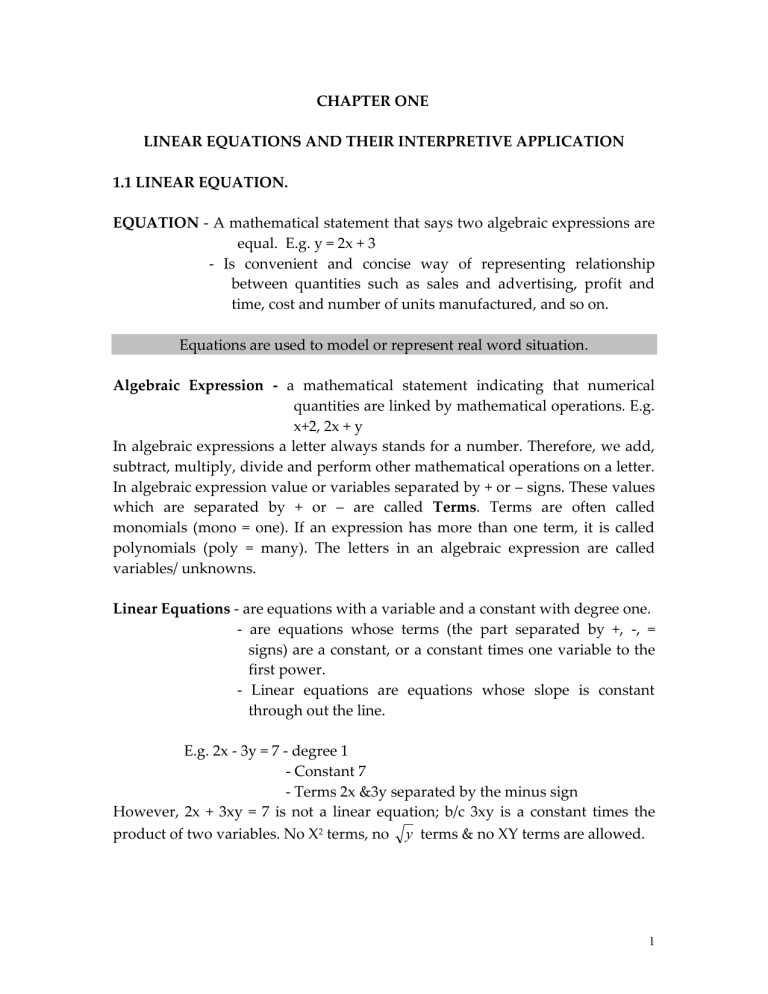
CHAPTER ONE LINEAR EQUATIONS AND THEIR INTERPRETIVE APPLICATION 1.1 LINEAR EQUATION. EQUATION - A mathematical statement that says two algebraic expressions are equal. E.g. y = 2x + 3 - Is convenient and concise way of representing relationship between quantities such as sales and advertising, profit and time, cost and number of units manufactured, and so on. Equations are used to model or represent real word situation. Algebraic Expression - a mathematical statement indicating that numerical quantities are linked by mathematical operations. E.g. x+2, 2x + y In algebraic expressions a letter always stands for a number. Therefore, we add, subtract, multiply, divide and perform other mathematical operations on a letter. In algebraic expression value or variables separated by + or – signs. These values which are separated by + or – are called Terms. Terms are often called monomials (mono = one). If an expression has more than one term, it is called polynomials (poly = many). The letters in an algebraic expression are called variables/ unknowns. Linear Equations - are equations with a variable and a constant with degree one. - are equations whose terms (the part separated by +, -, = signs) are a constant, or a constant times one variable to the first power. - Linear equations are equations whose slope is constant through out the line. E.g. 2x - 3y = 7 - degree 1 - Constant 7 - Terms 2x &3y separated by the minus sign However, 2x + 3xy = 7 is not a linear equation; b/c 3xy is a constant times the product of two variables. No X2 terms, no y terms & no XY terms are allowed. 1 The general notation of a linear equation is Y = mx + b, Where, m = slope b = y-intercept. It is worth noting that this formula or notation holds true for all lines that are not parallel to the y-axis. A vertical line is represented by the equation X=a. In cost out put relationship, b is the fixed cost, and m is the marginal cost. The cost is increases by the rate of the amount of the slope, m. Slope (M) = y rise / fall ) x run Y y X x 2 2 1 if X1 # X2 1 Slope measures the steepness of a line. The larger the slope the steeper the line is both in value & in absolute value. A line’s slope number tells us how much the line falls (or rises) for a stated change in x. Slopes can assume 4 different values: negative, positive, 0 and undefined. The line that is parallel to the X- axis is the gentlest of all lines, m= 0 The line that is parallel to the Y - axis is the steepest of all lines, m = The slope of a line is defined as the change taking place along the vertical axis relative to the corresponding change taking place along the horizontal axis, or, THE CHANGE IN THE VALUE OF Y RELATIVE TO A ONE - UNIT CHANGE IN THE VALUE OF X. In linear equation of Y= mx + b, the coefficient of the independent variable is the slope of the line and the constant that stands alone is the vertical (y) intercept. That is, Dependent variable = (slope x independent Variable) + Intercept. Intercepts - Those points at which the graph of a line, L, crosses the axes are called intercepts. The X-intercept is the point at which the line crosses the X-axis and it is found at (X, 0) and the Y-intercept is the point at which the y-axis is crossed. Its coordinate is at (0, y). DEVELOPING THE EQUATION OF A STRAIGHT LINE There are at least three way of developing the equation of a line, these are: 1. The slope - intercept form 2. The slope - point form 3. Two-points form. 2 1. THE SLOPE-INTERCEPT FORM This way of developing the equation of a line involves the use of the slope and the intercept to formulate the equation. Often the slope and y-intercept for a specific linear function are obtained directly from the description of the situation we wish to model. E.g. Slope=10 Y-intercept=20 A line that has a slope of 10 and a y-intercept of 20 has the following equation: Y=10x +20 2. Suppose the fixed cost (set up cost) for producing product x be Birr 2,000. After setup it costs Birr 10 per x produced. If the total cost is represented by y: 1. Write the equation of this relationship in slope intercept form. 2. State the slope of the line and interpret this number. 3. State the y-intercept of the line and interpret this number. 3. A Salesman has a fixed base salary of Br 200 a week. In addition, he receives a sales commission that is 20 percent of his total Birr values of sales. State the relationship between the salesman’s total weekly salary and his sales for the week. Answer: Y = 0.2x + 200 2. THE SLOPE - POINT FORM The equation of a non-vertical line, L, with slope, m that passes through the point (x, y is: Y-Y1 = m (X-X1). Slope = 4, point (1, 2), the equation becomes Y = 4X-2 2. A salesman earns a weekly base salary plus a sales commission of 20% of his total weekly sales. When his total weekly sales total Birr 1000, his total salary for the week is Birr 400. Derive the formula describing the relationship between total salary and sales. Answer: Y = 0.2x = 200 3. If the relationship between total cost and the number of units made is linear, and if cost increases by Birr 7 for each additional unit made, and if the total cost of 10 units is Br 180, find the equation of the relationship between total cost (Y) and number of units made (x). Answer: 7x + 110 3. TWO - POINTS FORM Two points completely determine a straight line and, of course, they determine the slope of the line. 3 Hence we can first compute the slope, and then use this value of slope (m) together with either point in the point-slope form: Y-Y1 =m (X-X1) to generate the equation of a line. Alternatively, the following formula can also be used: (Y-Y1) = y x 2 x2 y x 1 (X - X1) 1 E.g. 1. (1, 10) (6, 0) First, find the slope = 0 10 10 2 , then use the Slope-point form. 61 5 Y-Y1 = M (X-X1) = Y-10 = - 2 (X-1) Y-10 = -2X + 2 Y = -2X + 2 2. A sales man has a base salary and, in addition, receives a commission, which is a fixed percentage of his sales volume. When his weekly sales are Birr 1000, his total salary is Birr 400. When his weekly sales are Birr 500, his total salary is Birr 300. Determine his base salary and his commission percentage and express the relationship between sales and salary in equation form. Answer: Y = 0.2x + 200 3. A printer quotes the price of Birr 1,400 for printing 100 copies of a report and Birr 3000 for printing 500 copies. Assuming a linear relationship what would be the price for printing 300 copies? Answer: Birr 2,200. Horizontal and Vertical Lines Horizontal lines are lines whose slope is zero. These lines are parallel to the Xaxis. Vertical lines are lines whose slope is undefined. These lines are parallel to the Y-axis. When the equation of a line is to be determined from two given points, it is a good idea to compare corresponding coordinates because if the y values are the same the line is horizontal, and if the x values are the same the line is vertical. Example a) Given the points (3, 6) & (8, 6) - the line through them is horizontal because both y-coordinates are the same (6). The equation of the line becomes y=6. b) Given the points (5, 2) and (5, 12), the line that passes through them is vertical, and its equation is x = 5. If we proceed to apply the point - slope 12 2 10 , and if m = the line is vertical and procedure, we would obtain 55 0 the form of the equation is: x = constant. 4 Parallel and Perpendicular Lines Two lines are parallel if the two lines have the same slope, and two lines are perpendicular to each other if the product of their slopes is - 1 or the slope of one is the negative reciprocal of the slope of the other. However, for vertical and horizontal lines, (they are perpendicular to each other), this rule of m 1 . m2 = -1 doesn’t hold true. Example: 1. Y= 2x-10 and Y=2x+14 are parallel. 3 2 2. Y= x +10 and Y = x +100 are perpendicular to each other. 3 2 Lines through the Origin Any equation in the variables x and y that has no constant term other than zero will have a graph that passes through the origin. Or, a line that passes through the origin has an x-intercept and a y-intercept of (0,0). These lines are expressed in the form Y = mx. 1.2. APPLICATIONS OF LINEAR EQUATIONS 1.2.1. LINEAR COST-OUT PUT RELATION SHIPS - VC, FC, TC, AC, MC, TR, TP: TR line TC line TR TC TC= VQ+FC TP T G F TR = PQ T = TR - TC = PQ - (VQ + FC) = Q (P-V) + FC Where Q = units produced in cost & units sold in revenue. A B C D Q no of units (product) 5 Interpretation of the graph 1. The vertical distance AB, FC, GD is the same because fixed cost is the same at any level of output. 2. There is no revenue with out sales (Because total revenue passes through the Origin), but there is cost with out production (Because of total fixed cost) and the total cost function starts form A and doesn’t pass through the Origin. 3. Up to point T, total cost is greater than total revenue and results in loss while at point T, TR = TC = Break even (zero profit), and above point T, TR >TC and results in profit. 4. TFC remains constant regardless of the number of units produced, given that there is no any difference in scale of production. That is there is no either expansion or contraction of the business. 5. As production increases, TVC increases at the same rate and MC = V only in linear equations. 6. As production increases TC increases by the rate equal to the V = MC. 7. Unit variable cost V is the same through out any level of production, however AFC decreases when Q increases and ultimately ATC decreases when Q increases because of the effect of the decrease in AFC. 8. As Q increases TR increases at a rate of P and AR remains constant. TR p. Q AR = AR P in linear functions. Q Q 1.2.2. BREAK EVEN ANALYSIS BEP (Break even point) is the point at which there is no loss or profit to the company. It can be expressed either in terms of production quantity or revenue level depending on how the company states its cost equation. Manufacturing companies usually state their cost equation in terms of quantity (because they produces and sell) where as retail business state their cost equation in terms of revenue (because they purchase and sell) Case 1. Manufacturing Companies Consider a company with equation TR = PQ TC= VQ + FC At BEP, TR = TC PQe = VQe + FC PQe - VQe = FC Qe (P-V) = FC FC Qe = P V where: Qe = break even quantity FC = fixed cost P = unit selling price V= unit variable cost 6 1. 2. 3. 4. 5. 6. Assumptions of Breakeven Analysis Selling price is constant throughout the entire relevant range [relevant range – is the limit of cost-driver activity within a specified relationship between costs and the cost driver is valid]. Costs are linear over the relevant range. In multi-product companies, the sales mix is constant. In manufacturing firms, inventories do not change (Units produced = Units sold). Expenses may be classified in to variable and fixed categories. Total variable expenses vary directly with activity level. Total fixed expenses do not change with activity level. Efficiency and productivity will be unchanged. Example 1. A manufacturing company has a fixed cost of 10,000 and a unit variable cost of Birr 5. If the company can sell what it produces at a price of Birr 10, a. b. c. d. Write the revenue and cost and profit equations Find the breakeven point in terms of quantity and sales volume. Interpret the results. Show diagrammatically the TR, TC, TP, BEP, TFC & TVC The Effect Of Changing One Variable Keeping Others Constant on BEP Case 1: Fixed Cost Assume for the above problem FC is decreased by Br 5,000, citrus paribus. TC = 5Q + 5,000 Qe1 = 5,000 = 1,000 units 5 TR = 10Q FC Qc Therefore, FC & Qehave direct relationship FC Qc Case 2 - Unit variable cost Assume for the above problem unit variable cost decreased by Birr 1, citrus paribus 7 TC = 4Q + 10,000 Qe 2 10,000 = 1,667 units 6 TR=10Q Therefore, V Qc V & Qe have direct relationship V Qe Case 3- Selling Price Assume for the above problem selling price is decreased by Birr 1, Citrus Paribus. TC = 5Q + 10,000 Qe 10,4000 2,500 units 3 TR = 9Q P Qe P & Qe have indirect relationship P Qe In the above example if a company can’t produce and sell 5,000 units it has the following options: - Decreasing FC a) Decreasing unit variable cost b) Increasing the unit selling price If the organization is faced between cases two and three, it is preferable to decrease the unit variable cost because if we increase the selling price, the organization may loose its customers; and also decreasing the FC is advisable. Finding the Quantity level that involves profit or loss. FC 0 BEP = , Any Q is related to the cost, profit, --Pv TR TC = PQ - (VQ + FC) = Q (P-V) - FC Q( P V ) FC FC Q( P V ) FC Q For any quantity level. P V Example 1. For the above manufacturing company, (example one), if it wants to make a profit of Birr 25,000, what should be the quantity level? Answer: 5,000 units. This Therefore, 8 tells us when there is a profit; the quantities produced and sold have to be greater than the break-even quantity. 2. If it expects a loss of Birr 5,000, what will be the quantity level? Answer: 1,000 units. * When there is less, the quantity produced and sold should be less than the BEQ. Case 2 - Retail (Merchandise) Businesses. Break even Revenue = BEQ x P Assume a business firm with product A has the following cost and revenue items. Purchase cost of A = 100 Br Selling price = 150 Br Markup= Selling price - Cost = 150-100=50. Mark up can be expressed: i. As a function of cost, the mark-up is 50/100 = 50% ii. As a function of retail price, the mark up is 50 margin. The cost of goods sold = 150 33.3% , it is also called 100% 33.3% 66.6% 67% sellingprice m arg in cos tofgoodssold Selling expense = 1 percent of the selling price = 0.01x So, the total cost equation becomes: Y=0.68x + FC; Where X = sales revenue, and Y = total cost. The above 68% is interpreted as, Out of the 100% selling price 68% is the variable cost of goods purchased and sold. To get the break-even sales volume level, we equate the total cost, Y with the sales volume level, X as Xe = Y = X, Y = mx + b X = mx + b X – mx = b X (1 – m) = b Xe = b 1 – m; Where m= unit variable cost /Birr of sales. 9 Example 1. Suppose a retail business sells its commodities at a margin of 25% on all items purchased and sold. Moreover, the company uses a 5% commission as selling expense and Birr 12,000 as a fixed cost. Find the break-even revenue for the retail business after developing the TC equation. Answer: Y = 0.8x + 12,000 and Xe = Birr 60,000. It is interpreted as; when the company receives Birr 60,000 as sales revenues, there will be no loss or no profit. 2. It is estimated that sales in the coming will be Birr 6000 and that fixed cost will be Br 1000 and variable costs Birr 3,600. Develop the total cost equation, and find the breakeven revenue. Answer: Y = 0.6x + 1000; Xe = Birr 2,500. 3. A company sold 80,000 units earning a profit of Birr 90,000. The Total purchasing Cost of the product is Birr 400,000. Moreover, the company incurred a commission expense (additional cost) of Birr 40,000 at 5% rate. (Hint: commission expense is calculated as a percentage of sales). Develop the total cost equation and find the break-even revenue. Answer: Y = .55x + 270,000; Xe = Birr 600,000. The break-even revenue method is useful, because we can use a single formula for different goods so far as the company uses the same amount of profit margin for all goods. However, in breakeven quantity method it is not possible and hence we have to use deferent formula for different items. When the break-even revenue equation is for more than one item it is impossible Xe to find the break-even quantity. It is only possible for one item. By Qe = P where Xe = break-even revenue. P= Selling price. Qe = break-even quantity. Given that the company purchases and sells single product, to change the cost equation in terms of revenue in to a cost equation in terms quantity we have to multiply price by the coefficient of X that is m. To change the cost equation in terms of quantity in to a cost equation in terms revenue we divide the unit variable cost, V, by the corresponding unit selling price. ASSIGNMENTS 1. ABC’ company’s cost function for the next four months is C= 500,000 + 5q. Required: a) The break-even dollar volume of sales if the selling price is Birr 6 per unit. 10 b) What would be the company’s cost if it decided to shut down operations for the next four months? c) If, b/s of a strike, the most the company can produce is 100,000 units, should it shut down? Why or why not? 2. In its first year, “ABOL BUNA” Company had the following experience. Sales = 25,000 units Selling price = Birr 100 Total variable cost = Birr 1,500,000 TFC = Birr 350,000 Required: a) Develop revenues, cost, and profit functions for the company in terms of quantity. b) Find the break-even point in terms of quantity. c) Convert the cost equation in terms of quantity in to a cost equation in terms of revenue. d) Find the break-even revenue. e) If profit had been Birr 500,000 what would have been the sales volume (revenue) and the quantity of sales. f) What would have been the profit if sales were Birr 2,000,000? 3. A retail co plans to work on a margin of 44% of retail price and to incur other variable costs of 4%. If it expects fixed cost of Birr 20,000, a) Find the equation relating total cost to sales. b) Find the profit it sales are Birr 60,000. c) Find the breakeven revenue. d) If profit is Birr 15,000, what should be the revenue level? e) If the company has only one item at a price of Birr 15 per unit, how do you convert the cost equation in terms of revenue in to a cost equation in terms of quantity? 4. A small home business is set up with an investment of Birr 1,000,000 for equipment. The business manufactures a product at a cost of Birr 60 per unit. If the product sells for Birr 140, how many units must be sold before the business breaks even? 5. A certain car model cost Birr 20,000 with a gasoline engine and Br 25,000 with a diesel engine. The number of miles per gallon of fuel for cars with these two engines is 25 and 30, respectively. Assume that the price of both types of fuel is Birr 1.50 per gallon. Required: a) Drive the equation for the cost of driving a gasoline powered car. b) Drive the equation for the cost of driving a diesel powered car. 11 c) Find the break-even point, that is, find the mileage at which the dieselpowered car becomes more economical than the gasoline powered car. 6. A firm manufactures and markets a product that sells for Birr 20 per unit. Fixed costs associated with activity total Birr 40,000 a month, while variable cost per unit is Birr 10. A maximum of 10,000 units can be produced and sold. Required: a) Drive the TR, TC and Total profit functions. b) Sketch the TR, TC and Total profit functions in the same coordinate system. c) What is the Break-even point (in terms of quantity and sales volume)? d) Drive the new TC, Total profit functions given that FC is increased by Birr 10,000 a month, and calculate the new break-even point. e) Drive the new TC and Total profit functions given that unit variable costs is decreased by 20% and calculate the new Break-even point. f) Drive the new TR and Total profit functions given that the unit selling price increases by 20% and calculate the new break-even point. g) What is the relationship that you may inter from BEP& FC, P& BEP and V& BEP? h) Assume selling prince increases by 10% and at the same time V increases by 10% what is the effect of these changes on the BEP - calculate the new breakeven point. What lesson can we drive from this? i) Suppose there is no any change in FC, V and P, What is the maximum profit the firm can generate, and at what level of output? j) Keeping P and FC constant, what is the maximum unit variable cost for the firm to break even (at its maximum out put level)? k) Keeping all things as they are, what is the quantity level at which the company: i. Makes a profit of Birr 100,000? ii. Looses Birr 10,000? l) Had there been no capacity limitation, how would your answer have changed in part (i)? 12
